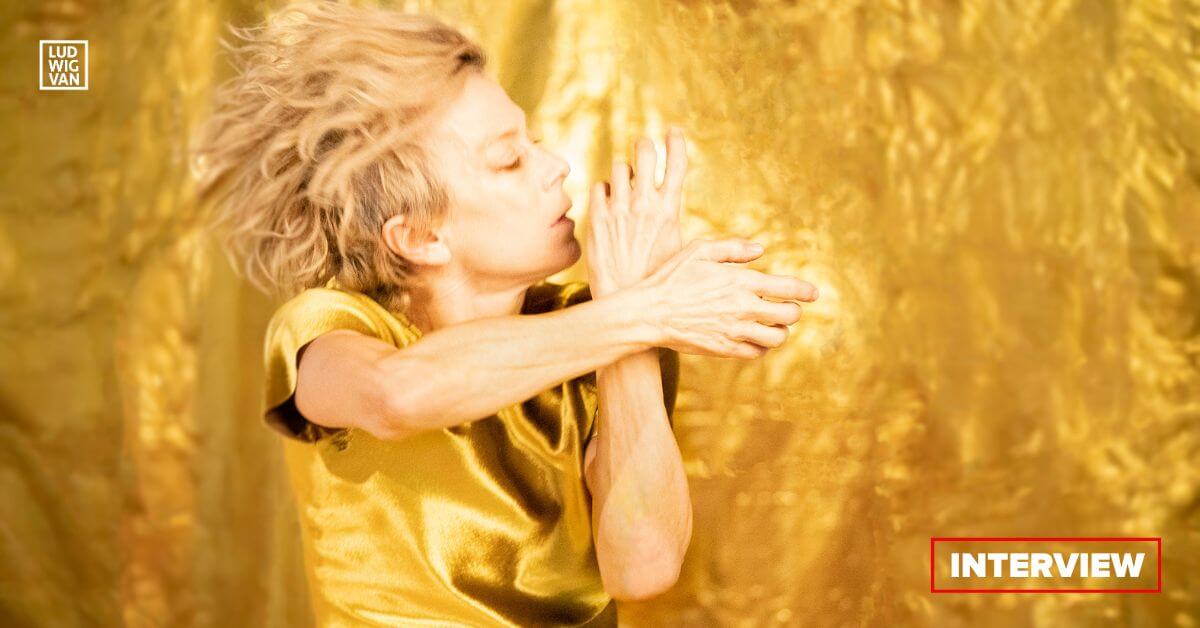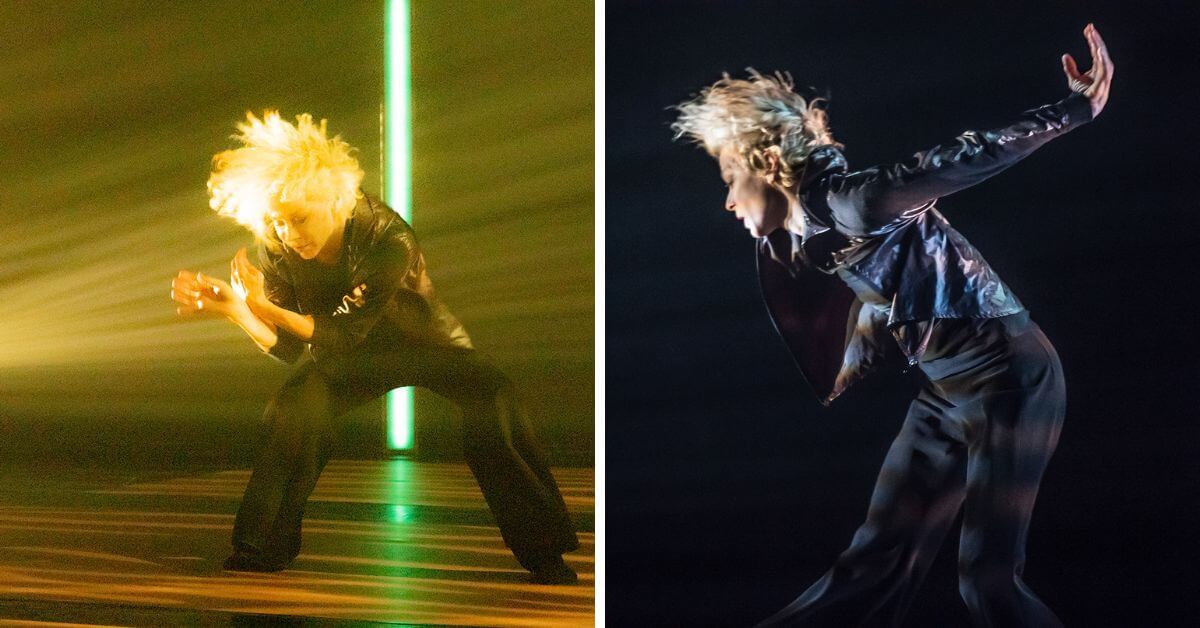
What more can be said of dance artist Louise Lecavalier that has not already been recorded?
During the 80s and 90s, the Montréal-born Lecavalier was arguably the most famous Canadian contemporary dancer in the world. Her claim to fame was being the lead dancer in Edouard Lock’s idiosyncratic, ground-breaking dance company, La La La Human Steps, a darling of European presenters. As muse to Lock, Lecavalier, a singular image with her muscular, compact body and punk androgyny, fearlessly performed the mind-boggling, explosive feats of physicality that the choreographer showered on her.
Lecavalier reached worldwide stardom as a guest on David Bowie’s Sound + Vision Tour in 1990. She also appeared in the pop star’s music video Fame ’90. After leaving Lock in 1999, she worked independently with other choreographers and theatre artists, including Canadian greats like Tedd Robinson and Crystal Pite. Lecavalier formed her own company, Fou glorieux, in 2006, for the creation of works tailored expressly for her. Along the way, she tried her hand at choreography.
To honour her distinguished career, Lecavalier was presented with the Order of Canada in 2010, and, in 2014, she received Canada’s most prestigious prize, the Governor General’s Performing Arts Award for Lifetime Artistic Achievement.
Now at the astonishing age of 64. Lecavalier is still going strong. When her acclaimed solo show Stations opens tonight at Harbourfront’s Fleck Dance Theatre for a three-day run, she will be performing her own choreography in a show that has been called her most personal work to date.
David Bowie works with Edouard Lock, Louise Lecavalier, and La La La Human Steps in 1988:
The Q&A
Lecavalier and I met by Zoom and had an in-depth discussion about the dancer’s life and times, and of course, Stations.
What keeps the creative force so alive in you?
It’s all a counter-balance. I can see beauty in the world, and that is what gives me the desire to go into the studio. Exploring movement makes me feel so good. I’m so lucky to be involved in something so beautiful. I ask questions, and even though I find not so perfect answers, I keep searching.
What is it like to be a 64-year-old dancer?
My memory of what I could do at 20 is selective. I’m not objective about the past. I never say that I can’t do as much as I once could. Rather, I say I’m doing things differently. My body hurts but it’s a different kind of pain. In fact, my body is as alive as my thoughts. There is an energy and a fire that is within me. There is something inside my stomach that burns.
Can you describe the 18 years you spent with Lock?
I’m a creative artist and so is he, and we grew together. He would give me steps and I had to interpret them, to make them work. You have to be true to a choreographer, but you can also be creative in your own interpretation, and that’s what gave me the most fun.
When you left Lock in 1999, you left the stage, and didn’t reappear until 2003. What did you do during those years?
I did workshops and master classes, but most importantly, I gave birth to twin daughters who are now 22, and they live upstairs in the duplex. Their father is a jazz musician.
I thought I would never have kids. It was such a funny idea to me, although I always liked them. For example, some of the Lock dancers had children with them when we were on tour, and I always got along with them, except near showtime. Then they would make me nervous and I didn’t want them around. That all changed when I had my own kids.
What made you decide to become a choreographer?
It happened by accident. In 2006, Benoît Lachambre had created a solo on me, and I phoned him about doing a duet together. I was used to choreographers giving me steps, but Benoît refused to do it, so in the duet Is You Me (2008), we each created our own part, and movement just poured out of me. This gave me the courage to create So Blue that premiered in Düsseldorf in 2012, and Benoît was the muse that made it happen.
Let’s talk about Stations, the dance you’re bringing to Toronto. What is the piece about?
There are four stations within the piece, and each corresponds to a specific theme that I explore in movement — fluidity, control, meditation, and obsession. I may start with something, but I don’t necessarily end there. Stations is a piece that just grew on its own. I see it as representing a cycle.
I began with the medieval mystic Marguerite Porete. In 2018, the Montreal theatre company UBU was creating a piece about her called Les Marguerites. They envisioned presenting her life in three parts using a dancer, an actress, and a young girl. Marguerite wrote a book called The Mirror of Simple Souls, which the Church deemed heresy, and she was burned at the stake in 1310. During her trial she remained silent and never defended herself. After the play, I felt there was good material here, and so I continued my own research. Marguerite was someone I wanted to pursue. She inspired the first station.
I understand that music plays a big part in Stations.
In fact, I wanted a musical world that was a powerful blast of varied musical inspirations.
For the second station, I fell in love with American saxophonist Colin Stetson and knew I had to do something with his music. The third station features songs from the joint album by two Montreal groups — Jerusalem in My Heart (electronic experimental Arabic folk music), and the rock band Suuns. The last station is a mix of Colin Stetson and the collaboration between Italian Teho Teardo and German Blixa Bargeld, whose music is considered German industrial. Some of the songs in this station have words.
Antoine Berthiaume composed the music for Station One, and also arranged the soundtrack.

That’s quite a mix of inspirations.
These four sections came together because things are so much more connected than we think they are. As humans, we are not just one thing; we are made up of many facets. The four words that represent the stations are not the only things in the piece. It’s more complex than that. As a dance work, Stations speaks differently to me at different times, and will speak differently to different people as well.
In your prime as a dancer, you dazzled with your remarkable physicality and technical wizardry. What is your choreography like, since you are creating for yourself?
My choreographic language evolves out of my movement research. I’d describe it as energetic, fluctuating, full of contrasts, abandoned but controlled, a quirky movement of opposites, and all pushed to the furthest limit.
I must point out that when I’m exploring movement by improvising to music, I inevitably end up with different music for the actual piece. I find it a relief to play with music. It’s a sensual experience that lightens the dance. It gives me an explosion of pleasure
Just like I was with Edouard, I keep the choreography the same in performance, but find my liberty within it. A dancer should never be sloppy. Precision is important within the interpretation. I could never improvise within a choreography, because I have to go deep into something that is established. That’s the freedom of dance that I love.
It’s hard to separate the dancer from the choreography. I call myself an artist. Everything in my life is mixed together. My art and my children are all one thing. I’m unified and not fragmented, On stage, I’m giving it all — all that I have — and I dance as I live. Everything is in my dance.
You debuted Stations in 2020 at tanzhaus nrw in Düsseldorf. It seems that Europe plays a big part in your career.
It always has, right from the Lock years. I tour mostly to Germany and France, but also Spain, Italy and London — and, of course, Canada. The United States, however, remains blocked. I miss Japan, but I’m not greedy for places. If I have 25 bookings, I consider that a good year.
I consider tanzhaus to be a second home to me, and I’ve premiered several pieces there. I love the way the audience is seated so that everyone can see. The director is very interested in my work. Our relationship began when I sent him a text and some pictures of a work that wasn’t even finished, let alone named, and he took it for his program.
My routine is to make a work and then tour it. I’m currently creating a piece with director/clown François Bluin to debut in Düsseldorf in 2024.
I know you have a special affinity for Toronto.
I love appearing here because Toronto audiences always got what Edouard was trying to do. While I enjoy developing new audiences, it’s great performing in a place that knows your history. There’s a continuity. The audience knows where the piece comes from. They understand the path of creation.
- Stations opens tonight at Toronto’s Harbourfront, with performances until the 25th. Tickets and more information [HERE].
Are you looking to promote an event? Have a news tip? Need to know the best events happening this weekend? Send us a note.
#LUDWIGVAN
Get the daily arts news straight to your inbox.



